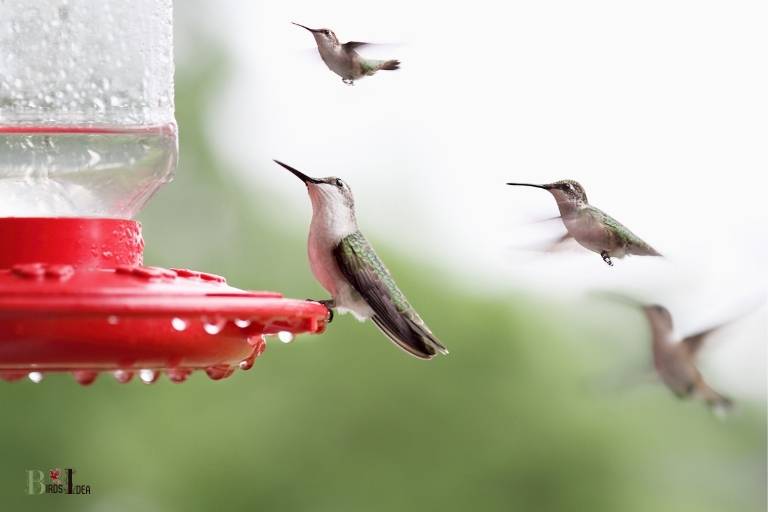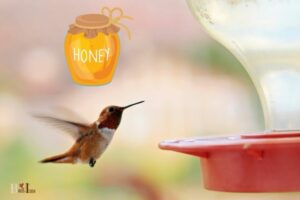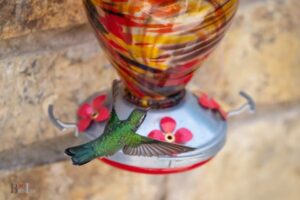Do Hummingbirds Remember Where Feeders are: Yes!
Yes, hummingbirds remember where feeders are due to their excellent spatial memory and ability to associate locations with food sources.
Hummingbirds have an incredible memory when it comes to finding food sources, such as feeders. They use their keen spatial memory to recall the locations of numerous feeders and flowers within their territory.
Their memory allows them to visit and revisit feeders multiple times a day, ensuring they receive enough energy to sustain their high metabolism.
Hummingbirds’ spatial memory plays a significant role in their ability to locate and remember feeders. Their incredible memory allows them to create mental maps of their territories, which can span several miles, and efficiently visit multiple feeders daily.
This skill not only helps them find reliable food sources but also saves energy by reducing the amount of time spent searching for nectar.
Encouraging hummingbirds to visit your feeder regularly by keeping it clean and filled with fresh nectar ensures that they will remember its location and return frequently.
6 Aspects: About Hummingbirds Feeders Remember
| Aspect | Description |
| Memory | Hummingbirds have excellent memories |
| Feeder location | They can remember the exact location of feeders |
| Time management | They track the time since last feeding from a specific feeder |
| Familiarity | They can recognize and remember territory |
| Seasonal migration | They can return to feeder locations year after year |
| Individual feeder | They can distinguish between different feeders |
Key Takeaway

Five Facts About: Hummingbirds Feeders Remember
What Is The Memory Capacity Of Hummingbirds?
Do Hummingbirds Remember Where Feeders Are?
Hummingbirds are amazing creatures that are known for their impressive cognitive abilities, including memory retention. A common question that people have regarding hummingbirds is whether they remember where feeders are.
In this section, we will explore the memory capacity of hummingbirds, their cognitive capabilities, research studies on hummingbird memory retention, how they compare to other bird species in terms of memory capacity, and how memory affects their ability to find feeders.
Explanation Of The Cognitive Capabilities Of Hummingbirds
Hummingbirds have some of the most advanced cognitive capabilities of any bird species. They are capable of complex problem-solving, recognizing patterns, and have excellent vision.
They also have an exceptional memory that allows them to remember food sources, migration routes, and the location of nesting sites.
Their cognitive abilities are so advanced that they can remember different flower species and associate them with the nectar they contain.
Research Studies On Hummingbird Memory Retention
Studies have shown that hummingbirds have an impressive memory retention. They can remember the location of food sources for weeks, even after they have been depleted.
Research conducted by the university of british columbia found that hummingbirds can remember the location of feeders for up to 28 days.
These findings suggest that hummingbirds have excellent long-term memory that can help them survive in harsh environments.
How Hummingbirds Compare To Other Bird Species In Terms Of Memory Capacity
Hummingbirds have a more impressive memory capacity than most other bird species. They are comparable only to birds such as crows and parrots that are known for their advanced cognitive abilities.
While some bird species can remember where food is, hummingbirds are unique in their ability to remember the location of multiple feeders, even when they are not visible.
How Memory Affects The Hummingbird’S Ability To Find Feeders
A hummingbird’s memory is crucial to its survival. They need to find and remember the location of multiple feeders to maintain their energy levels and survive in their environment.
Their excellent memory allows them to bypass empty feeders and find the most productive ones, which are vital to their survival.
Hummingbirds have exceptional cognitive abilities, including an impressive memory capacity that enables them to remember the location of multiple feeders for extended periods.
Their memory retention allows them to find the most productive feeders and avoid wasting energy searching for empty ones.
The cognitive capabilities of hummingbirds make them a fascinating species to study and observe.
Do Hummingbirds Use Spatial Memory?
Hummingbirds are fascinating creatures that capture our attention with their bright colors and lightning-fast movements. They zoom around, flitting from flower to flower, sipping nectar and seemingly never getting lost.
But how do they do it? Do hummingbirds remember where feeders are?
In this post, we will focus on the subheading ‘do hummingbirds use spatial memory? ‘ And explore how these tiny birds use spatial memory to locate feeders. Let’s jump right in and find out!
Explanation Of Spatial Memory And Its Importance To Birds
Before we discuss how hummingbirds use spatial memory, let’s briefly define what it means. Spatial memory is the ability to remember particular locations or spatial relationships between objects.
In other words, it is the memory of where things are in relation to each other.
Spatial memory is vital for creatures that navigate their environment, and it’s crucial for many bird species, including hummingbirds.
Research Studies On How Hummingbirds Use Spatial Memory To Locate Feeders
There have been several studies on how hummingbirds use spatial memory to locate feeders. One study, conducted by researchers at the university of british columbia, found that hummingbirds can remember the location of a food source for at least 28 days.
This means that when a bird returns to a location where a feeder was previously located, it will search for the feeder in the same spot where it was before, demonstrating long-term spatial memory.
Another study, conducted by researchers at the university of california, davis, found that hummingbirds navigate using spatial memory and landmarks.
The researchers found that when food sources were placed in novel locations, the birds relied heavily on landmark cues to locate them.
This means that hummingbirds use both spatial memory and visual landmarks to locate feeders.
Factors That Influence Hummingbird’S Spatial Memory
Several factors can influence a hummingbird’s spatial memory. One of these factors is the frequency of feeder replenishment. Hummingbirds are more likely to remember a feeder’s location if the feeder is refilled regularly.
Additionally, the size and color of the feeder can affect how well hummingbirds remember its location.
A brightly colored feeder, particularly red, is more memorable to hummingbirds, as they are attracted to bright colors.
Hummingbird’S Ability To Recall The Location Of Multiple Feeders
Many of us enjoy having multiple feeders in our yards to attract as many hummingbirds as possible. But can hummingbirds remember the location of multiple feeders?
The answer is yes! Research has shown that hummingbirds can remember the location of multiple feeders and will visit each of them in turn.
In fact, they can maintain spatial memories of up to several feeders simultaneously.
Hummingbirds use spatial memory and landmarks to locate feeders and can remember the location of a feeder for up to 28 days. The frequency of feeder replenishment and the feeder’s size and color can influence their spatial memory.
Finally, hummingbirds have the ability to recall the location of multiple feeders.
Now that we know more about hummingbirds’ incredible spatial memory skills, we can appreciate these tiny birds even more!
Long-Term Memory In Hummingbirds
Hummingbirds are one of the most fascinating creatures on the planet. They possess unique abilities that capture the imagination of many, including their long-term memory.
In this section, we’ll explore the topic of long-term memory in hummingbirds, particularly their ability to remember where feeders are located.
Overview Of Long-Term Memory Retention And Retrieval
Hummingbirds have a remarkable ability to retain and retrieve long-term memories. These memories allow them to find food sources when they need them.
Their long-term memory retention and retrieval abilities are a significant advantage that ensures their survival.
Here are some key points to consider about the long-term memory retention and retrieval of hummingbirds:
- The part of the hummingbird brain that is responsible for long-term memory is larger in proportion to the rest of their brain than in other birds.
- Hummingbirds are capable of memorizing the location of multiple flower patches, which allows them to compete with other hummingbirds for food sources.
- Unlike most birds, hummingbirds can remember the location of flower patches without relying on visual cues such as landmarks.
Longer-Term Memory Studies With Hummingbirds And Feeder Location
Several studies have been conducted to investigate the long-term memory capabilities of hummingbirds and their ability to recall the location of feeder sources.
A recent study conducted by the university of sussex found that hummingbirds can remember a specific feeder location for up to 14 days without reinforcement.
Here are some key points to consider about longer-term memory studies with hummingbirds and feeder location:
- In the study mentioned above, researchers moved the feeder every day after multiple visits from the hummingbirds until reaching a new location approximately 30 meters away.
- The hummingbirds were able to find the new location and consume the nectar without any hesitation, displaying a remarkable long-term memory.
- This ability of hummingbirds to remember specific feeder locations for extended periods shows that they can adjust their behavior in response to environmental changes.
How Long Hummingbirds Can Remember Specific Feeder Location
Hummingbirds’ memory retention of feeder locations varies. One study revealed that they can remember a specific feeder’s placement for five days, while another study has found that the time for which they can remember can differ according to the reinforcement schedule.
Here are some key points to consider when discussing how long hummingbirds can remember specific feeder locations:
- How frequently a hummingbird visits the same feeder and the time between visits affects memory retention.
- Researchers found that reinforcement provided throughout the day, or in short intervals, kept the hummingbirds remembering the feeder location for a longer time (five days), compared to reinforcement over extended periods or once a day.
Discussion Of Why Long-Term Memory Is Important To Hummingbirds
Long-term memory is crucial for hummingbirds to survive in their natural habitat. It allows them to remember the location of the flowers and feeders they visit and to navigate the environment in search of food and other resources.
Here are some points to consider about the importance of long-term memory to hummingbirds:
- Hummingbirds need to visit hundreds of flowers each day to meet their high energy requirements, and having good long-term memory helps them conserve energy by allowing them to find food as quickly and efficiently as possible.
- Hummingbirds need to remember their migration routes; without good long-term memory, they would be at risk of getting lost in their journey.
- Long-term memory retention allows them to recall a good supply of nectar, which is essential to their survival.
Hummingbirds have an astonishing ability to remember the location of flowers and feeders, thanks to their impressive long-term memory. By understanding their memory retention and retrieval capabilities, we can learn more about these fascinating and incredible little birds.
How Do Other Factors Affect Hummingbird Memory?
Hummingbirds are fascinating creatures to observe. Their ability to hover, fly backwards and upside down, and move with such agility and speed is admirable. But did you ever wonder if they have a good memory?
More specifically, do hummingbirds remember where feeders are?
Today, we’ll explore this topic and expound on how different factors affect hummingbird memory.
Discussion Of How The Weather Or Other Environmental Factors Might Affect Hummingbird Spatial Memory
Hummingbirds are sensitive creatures, and their spatial memory can be impacted by several environmental factors.
Some of the most notable ones include:
- Temperature: Extreme temperatures can negatively impact hummingbird memory. High temperatures make nectar ferment or evaporate quicker, making it difficult for hummingbirds to locate the feeders. On the other hand, low temperatures can cause nectar to freeze.
- Wind: Strong winds can move the feeders around, making it harder for hummingbirds to locate them. High winds can also sway flowers and consume nectar.
- Rain: Humidity can affect nectar’s concentration and consistency, making it harder for birds to locate. Additionally, rainfall can wash away nectar, making the feeders empty.
Explanation Of How Flowering Seasons Might Impact Hummingbird Memory
Hummingbirds can have impressive memory when it comes to finding food sources.
However, their memory could be impacted by the following factors during flowering seasons:
- Flowering patterns: Depending on the location, some species of hummingbirds may have to adapt to changes in the blooming seasons of certain plants.
- Flower density: Hummingbirds tend to remember the location of feeders better if there’s a higher density of flowers in the area. The more abundant the flowers, the less reliant hummingbirds are on their memory.
- Non-native plants: Some non-native flower species might attract hummingbirds, but they may not recall the location of the feeders as well as native plants.
Discussion On How Different Feeder Types Might Impact Memory
Hummingbirds tend to remember the location of feeders that have similar features.
Here are some considerations to keep in mind:
- Color: Studies suggest that hummingbirds are attracted to the color red, but they also like shades of pink, orange, and yellow. Any feeder containing those colors could help attract hummingbirds and aid their memory.
- Shape: Feeders with a similar shape to flowers might be easier for hummingbirds to remember. Additionally, feeders that resemble tube-shaped flowers will be easier for hummingbirds to feed from.
- Placement: The placement of the feeder might also affect a hummingbird’s memory. If the feeder is hung or placed in the same location every time, it can help birds remember its location.
Overview Of Potential Impacts Of Human Interference On Hummingbird Memory
Human activity can have a significant impact on hummingbird memory.
Here are some noteworthy points:
- Feeder placement: If humans frequently move or change the feeder’s location or color, it can confuse the hummingbirds and affect their memory.
- Frequency of feeder changes: Hummingbirds establish a routine and remember the location of the feeders, so if humans do frequent modifications to the feeder, then it can create confusion for the hummingbirds.
- Noise: Loud human noises around the feeder location might create discomfort for the hummingbirds and affect their memory.
Hummingbirds have an incredible memory, but different environmental factors can impact it. Providing food sources with similar features to flowers, such as color and shape, can help hummingbirds remember their location.
Meanwhile, migration patterns, flowering seasons, and human activity could result in hummingbirds forgetting the location of feeders.
To keep their memory sharp, we must be mindful of our impact on the natural world.
FAQ Of Do Hummingbirds Remember Where Feeders Are
Do Hummingbirds Have Good Memory?
How Far Can A Hummingbird Remember A Feeder?
How Do Hummingbirds Locate Their Feeders?
Can Moving A Hummingbird Feeder Confuse Them?
Conclusion
As we’ve explored, hummingbirds are intelligent creatures with a unique set of memory abilities that allow them to remember the location of feeders and individual flowers. These tiny birds use different cues to find their food sources, including visual landmarks, spatial memory and scent recognition.
While we can’t say for certain that all hummingbirds remember where feeders are, their impressive cognitive abilities suggest that they are capable of doing so. Additionally, the longevity and annual migration patterns of hummingbirds further support their ability to remember locations.
As we continue to study these fascinating birds, we will likely gain further insight into their remarkable memory skills and how they are able to navigate over long distances.
One thing is certain, hummingbirds are much more than just cute, tiny creatures; they are intelligent, adaptable and endlessly fascinating.






